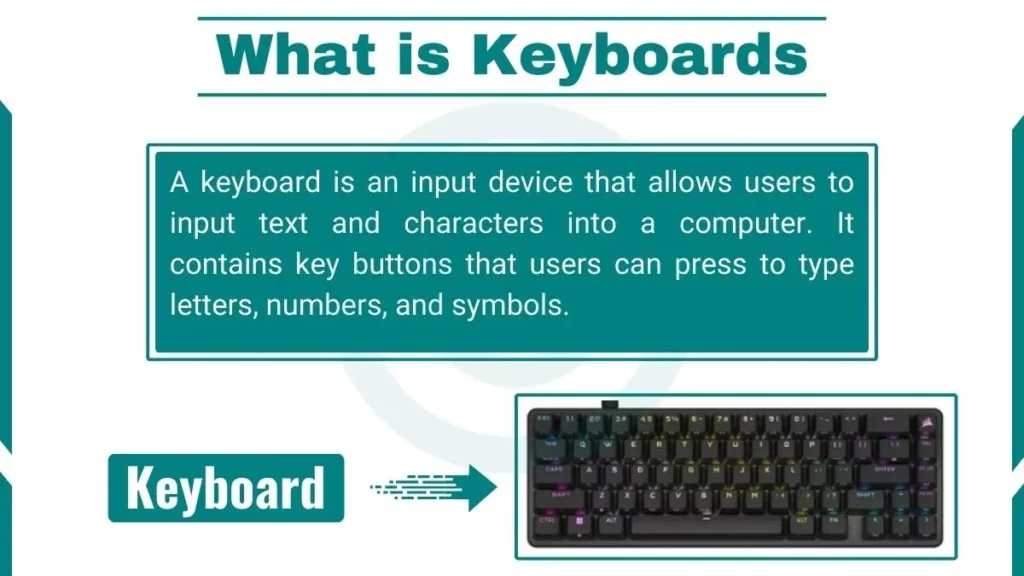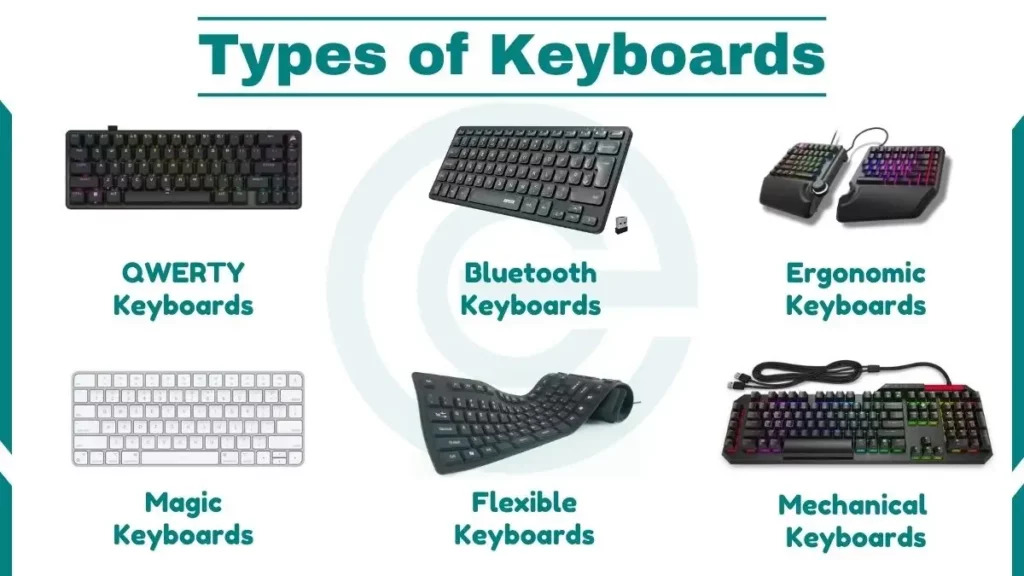A keyboard is an input device that allows users to input text and characters into a computer. It contains key buttons that users can press to type letters, numbers, and symbols.
When a user presses a key, it sends an electrical signal to the computer to identify which character or function is associated with it.

Evolution of Computer Keyboards
Journey of Computer Keyboards from Clunky Typewriters to Sleek Modern Designs:
In the early 20th century, keyboards were mechanical monsters. The keys required a lot of effort just to type a single letter onto the page. However, the iconic QWERTY layout was born during this era. Which remains the standard for modern keyboards.
The first big upgrade came with electric models, which used electrical signals to detect key presses. This made typing much lighter and faster. The real keyboard revolution arrived with the dawn of personal computers in the 70s and 80s. Dedicated function keys gave users shortcuts for common commands.
Today’s keyboards are all about ergonomics and efficiency. Laptop keyboards are thinner and quieter than ever before. Now keyboards can even adapt to multiple devices at once, as we increasingly switch between smartphones, tablets, and computers.
Features of keyboard
- It has keys that you press to input data into a device
- It allows you to type letters, numbers, and other characters
- It enables you to write documents, code programs, search the internet, and more
- Keys like Shift, Ctrl, and Alt act as modifiers for accessing additional characters and functions
- It connects to your device, whether a computer, laptop, smartphone, or tablet, with a wire or wirelessly
- Keyboards have special function keys (F1 – F12) for quick access to certain functions
Types of Keyboards
Here are the different types of keyboards:

1. QWERTY Keyboards
QWERTY keyboards are the most common type of keyboard. They get their name from the first 6 letters on the top letter row. The QWERTY design was created for early mechanical writing machines to stop the keys from getting stuck when used quickly. Modern keyboards still use this layout because most people are already comfortable with it.
2. Wired Keyboards
Wired keyboards connect directly to a computer device using a USB or similar cable. The cable provides power to the keyboard so wired keyboards do not require batteries or charging.
3. Ergonomic Keyboards
Ergonomic keyboards have an angled and split key layout designed to match the natural positions of the user’s hands and wrists. This helps the users to avoid strain and injuries from long typing times. Features like detachable palm rests, programmable keys, and tilt changes additionally improve comfort.
4. Wireless Keyboards
Wireless keyboards link to a computer using radio signals instead of a wire. Most wireless keyboards work up to 30 feet away from the receiver. This allows better flexibility to place the keyboard comfortably at a workstation. Wireless keyboards require batteries or charging to maintain the wireless connection.
6. Bluetooth Keyboards
Bluetooth wireless technology enables keyboards to connect to supporting devices like computers, tablets, or phones over short ranges. Bluetooth connections do not rely on line-of-sight positioning like infrared. Bluetooth allows one keyboard to switch interactions between multiple devices consistently. The lower energy use of Bluetooth allows for better battery life compared to early wireless keyboards.
7. Magic Keyboards
Magic keyboards are designed by Apple specifically for their Mac line of computers. It uses its technology and design for a responsive, stable, and power-efficient wireless connection. The slim keyboard profile allows for easy packing and portability. Backlit keys automatically adjust to lighting conditions.
8. Backlit Keyboards
Backlit keyboards contain LED lights beneath the keycaps to light up the individual keys. This makes it easy to spot keys positioned on a keyboard in low-light environments. Many backlit keyboards allow adjustments to the brightness settings. Backlighting does consume more keyboard power.
9. Gaming Keyboards
Gaming keyboards are designed with features to improve the gaming experience including programmable macro keys, technology to recognize fast keypresses, and ergonomic key positioning. Many gaming keyboards feature brightly colored, customizable backlighting across keyboard zones.
10. Flexible Keyboards
These keyboards use thin circuits to allow for repeated bending and folding of the keyboard surface without breaking. This makes them easy to carry by rolling or stuffing them into bags. It connects wirelessly by Bluetooth to pair with mobile devices.
11. Mechanical Keyboards
Mechanical keyboards use separate spring-loaded switches under each key instead of a single rubber membrane layer. When you press a key, it presses down on a switch stem with precise activation points to register the keystroke. Different switch types give tactile or auditory feedback, like a click or bump feeling when pressed.
Keyboard Components
Computer keyboards consist of:

- Alphanumeric keys for typing
- Function keys for quick access to commands
- Modifier keys like Shift and Control
- Navigation keys such as arrows and Home/End
- Special keys like Enter and Escape
Additional components include:
- Indicator lights signaling Caps/Num Lock status
- Multimedia keys for media playback control
- Numeric keypad for efficient number input
- Programmable keys and wrist rests on some models
Function of Keyboard keys in Computer
Here are the main functions of keyboard keys:
- Alphabet keys: used to enter letters a-z and A-Z. Allows the user to type documents, code, names, or other textual information.
- Number keys: used to enter number digits 0-9. Allows the user to type numerical information, and perform calculations or number-related computer tasks.
- Symbol keys: used to enter symbols like @, #, $, %, etc. Provides access to special characters which may be needed while typing.
- Spacebar key: creates spaces between words or characters. Used for word separation and readability.
- Enter/Return key: indicates the end of a text line or text input. Moves input to next line or submits entered text/commands.
- Backspace key: helps delete text that is to the left of the cursor location. Rectifies typing errors.
- Caps Lock key: switches between lower case and UPPER CASE TEXT INPUT. Allows for both regular and capitalized typing.
- Function keys (F1 to F12): trigger different programmed functions depending on the application. Usually shortcuts to specific menu options.
- Special keys (Ctrl, Alt, Shift, Cmd/Meta): modifier keys used in keyboard shortcuts in combination with other keys. Customizes commands and inputs.
Keyboard Layouts
Here are common keyboard layouts:
- QWERTY (English standard layout): QWERTY layout was designed for old mechanical typewriters. By splitting up common letter pairs, it reduced jams from keys sticking together.
- AZERTY (French layout): The French AZERTY keyboard puts the French home row (A Z E R T Y) front and center for easier access to accented letters.
- QWERTZ (German layout): On German QWERTZ keyboards, the Y and Z are swapped compared to QWERTY to better serve the German language.
- Dvorak (efficient English layout): Dvorak keyboard layout aims to minimize finger movement for ergonomic typing. Keys are arranged to make typing fluid and comfortable.
Topic Quiz
1. What is a keyboard primarily used for?
- A) To input data into a computer or device
- B) To connect to the internet
- C) To play games
- D) To store data
Correct answer: A) To input data into a computer or device
2. What is the name of the layout used in most modern keyboards?
- A) AZERTY
- B) DVORAK
- C) QWERTZ
- D) QWERTY
Correct answer: D) QWERTY
3. What is the purpose of the “Shift” key on a keyboard?
- A) To switch between uppercase and lowercase letters
- B) To delete characters to the left of the cursor
- C) To trigger programmed functions
- D) To navigate between lines of text
Correct answer: A) To switch between uppercase and lowercase letters
4. What is the term used to describe keyboards that provide tactile feedback to the user’s fingers?
- A) Backlit keyboard
- B) Haptic keyboard
- C) Mechanical keyboard
- D) Flexible Keyboard
Correct answer: B) Haptic keyboard
5. What is the purpose of the Enter/Return key on a keyboard?
- A) To indicate the end of a text line or text input
- B) To create spaces between words or characters
- C) To delete text that is to the left of the cursor location
- D) To switch between lowercase and UPPER CASE text input
Correct option: A) To indicate the end of a text line or text input
FAQs
What is a backlit Keyboard?
A backlit keyboard is a keyboard that has lights behind or underneath the keys to illuminate them. This makes the keys visible in dim lighting or darkness.
What is a haptic keyboard?
A haptic keyboard is a keyboard that provides tactile feedback to the user’s fingers when typing. It uses vibrations to mimic the feel of pressing physical keys, without actually having moving parts.
What is keyboard ghosting?
Keyboard ghosting is when you press multiple keys on a keyboard at once, but not all of the keystrokes are registered properly. This happens because most keyboards can only recognize a limited number of simultaneous key presses due to their design.


